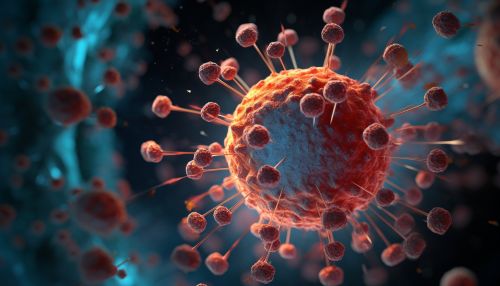Viral evolution
Introduction
Viral evolution is a complex process that involves the accumulation of genetic changes over time. This process is driven by the interaction between the virus and its host, as well as the environment in which the virus exists. Viral evolution is a critical aspect of virology, the study of viruses and their role in disease.
Mechanisms of Viral Evolution
Viruses evolve through several mechanisms, including mutation, recombination, and reassortment. These processes can occur independently or in combination, leading to the emergence of new viral strains and species.
Mutation
Mutation is a primary driver of viral evolution. Viruses, particularly RNA viruses, have high mutation rates due to the lack of proofreading mechanisms during replication. This results in a diverse population of viral variants, known as a quasispecies, within a single host. The high mutation rate allows the virus to adapt quickly to changing environments and host defenses.
Recombination
Recombination occurs when two different viral genomes co-infect the same host cell and exchange genetic material. This process can lead to the creation of new viral strains with different properties than their parent strains. Recombination is a common mechanism of evolution in many viruses, including HIV and hepatitis C virus.
Reassortment
Reassortment is a specific type of recombination that occurs in viruses with segmented genomes, such as influenza virus. During reassortment, different viral segments can be packaged into a single virion, resulting in a new strain with a combination of genes from the parent viruses.
Factors Influencing Viral Evolution
Several factors can influence the rate and direction of viral evolution, including host immunity, viral population size, and environmental conditions.
Host Immunity
The host immune response plays a significant role in driving viral evolution. Viruses must continually evolve to escape the host's immune defenses, a process known as immune evasion. This can result in the emergence of viral strains that are resistant to the host's immune response.
Viral Population Size
The size of the viral population within a host can also influence the rate of viral evolution. Larger viral populations have a higher chance of generating beneficial mutations, allowing the virus to adapt more quickly to changing conditions.
Environmental Conditions
Environmental conditions, such as temperature and humidity, can influence viral evolution by affecting the virus's survival outside the host. Changes in these conditions can drive the evolution of viral traits that enhance survival and transmission.
Impact of Viral Evolution
Viral evolution has significant implications for human health and disease. The emergence of new viral strains can lead to outbreaks of infectious diseases, some of which can become pandemics. Viral evolution also poses challenges for the development of effective vaccines and antiviral therapies.
Disease Emergence and Pandemics
New viral strains resulting from viral evolution can cause outbreaks of infectious diseases. In some cases, these outbreaks can escalate into pandemics, as seen with the 2009 H1N1 pandemic and the COVID-19 pandemic.
Vaccine and Antiviral Development
Viral evolution can complicate the development of vaccines and antiviral therapies. Viruses can evolve resistance to antiviral drugs, rendering them ineffective. Similarly, the emergence of new viral strains can reduce the effectiveness of vaccines, necessitating the development of new vaccines.
See Also


